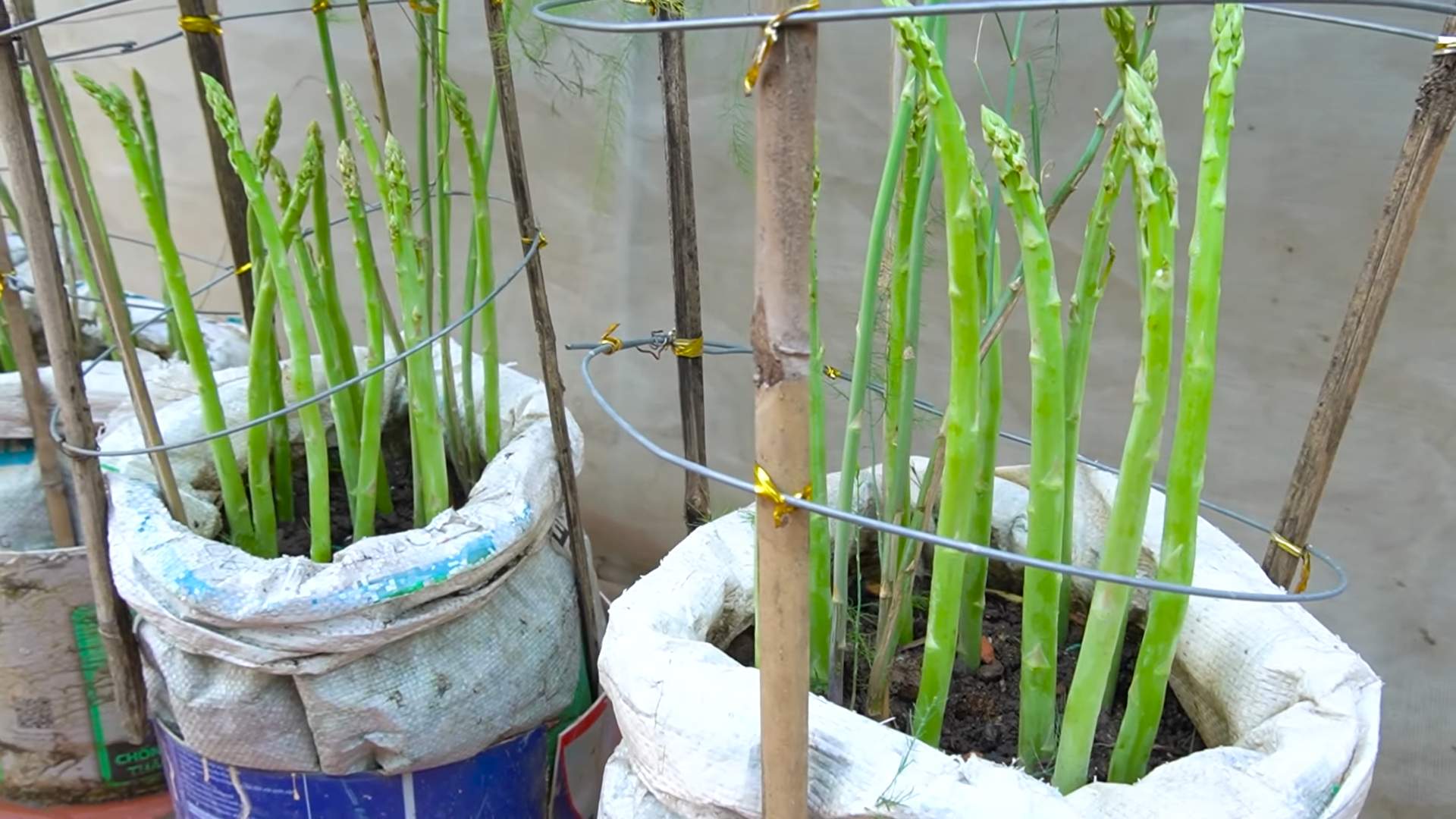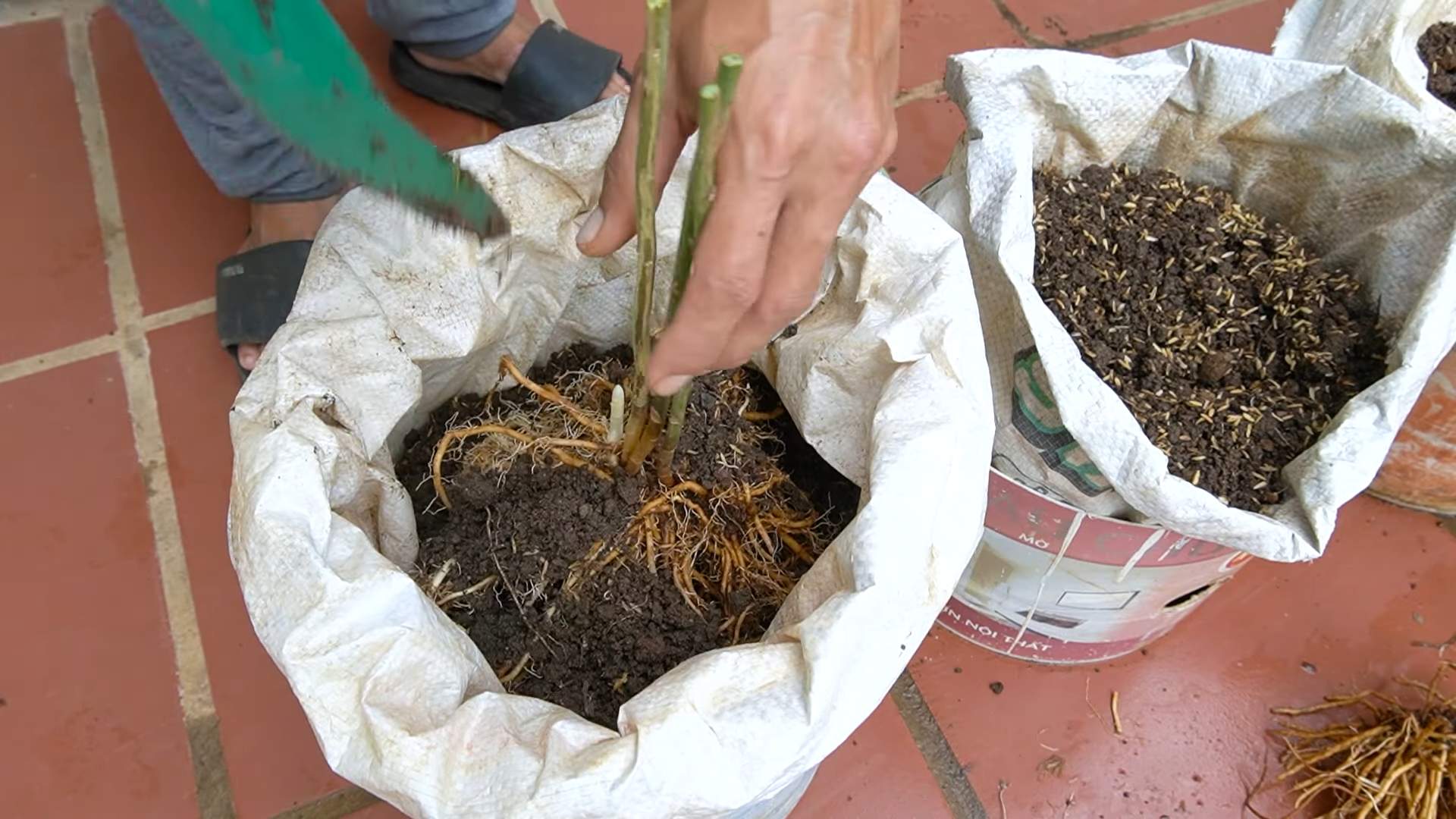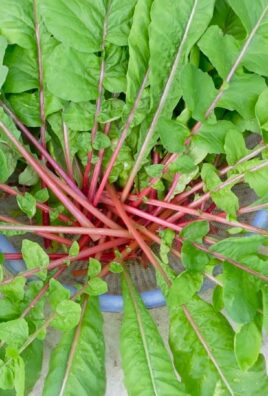Growing Asparagus at Home might seem like a challenge reserved for seasoned gardeners, but I’m here to tell you it’s totally achievable, even if you’re just starting out! Imagine stepping into your backyard and harvesting your own fresh, tender asparagus spears – a culinary delight that’s far superior to anything you’ll find in the grocery store.
Asparagus has a rich history, dating back to ancient Greece and Rome, where it was prized for its medicinal properties and delicate flavor. The Romans even developed sophisticated cultivation techniques to ensure a steady supply of this coveted vegetable. Today, we can tap into that legacy and bring this ancient delicacy into our own gardens.
Why should you bother with growing asparagus at home? Well, for starters, freshly picked asparagus is incredibly flavorful and nutritious. Plus, it’s a perennial crop, meaning you plant it once and enjoy harvests for up to 20 years! In this article, I’ll share my favorite DIY tricks and hacks to help you successfully cultivate this rewarding vegetable, regardless of your gardening experience. From choosing the right variety to preparing your soil and protecting your plants from pests, I’ll guide you through every step of the process. Get ready to enjoy the satisfaction of growing your own delicious and healthy asparagus!

Growing Asparagus at Home: A Beginner’s Guide
Asparagus, that delicious and slightly earthy spring vegetable, is surprisingly easy to grow at home once you understand its quirks. It’s a long-term commitment, yes, but the rewards of fresh, homegrown asparagus are well worth the wait. I’m going to walk you through everything you need to know to get started, from choosing the right location to harvesting your first spears.
Understanding Asparagus: A Perennial Delight
Asparagus is a perennial plant, meaning it will come back year after year. This is fantastic news, but it also means you need to choose your planting location carefully. Think of it as a permanent fixture in your garden. Once established, an asparagus bed can produce for 15-20 years!
Before we dive into the nitty-gritty, let’s cover some essential asparagus facts:
* Patience is Key: Asparagus takes time to mature. You won’t be harvesting a bumper crop in the first year. In fact, you shouldn’t harvest at all in the first year, and only lightly in the second. This allows the plants to establish strong root systems.
* Sunlight is Essential: Asparagus needs at least 6-8 hours of direct sunlight per day. The more sun, the better!
* Well-Drained Soil is a Must: Asparagus hates soggy feet. Make sure your soil drains well. Amend heavy clay soil with plenty of organic matter.
* Choose the Right Variety: There are male and female asparagus plants. Male plants generally produce more spears because they don’t expend energy on seed production. ‘Jersey Knight,’ ‘Jersey Giant,’ and ‘Jersey Supreme’ are all excellent all-male varieties. ‘Purple Passion’ is a popular variety known for its beautiful purple spears.
* Starting from Crowns vs. Seeds: You can grow asparagus from seeds, but it takes much longer (an extra year or two) to get a harvest. Starting with crowns (one-year-old plants) is the faster and more common method.
Phase 1: Preparing Your Asparagus Bed
This is arguably the most important step. A well-prepared bed will set your asparagus up for years of success.
1. Choose Your Location: As mentioned before, select a spot that gets plenty of sun and has well-drained soil. Consider the mature size of the plants; they can get quite large (3-5 feet tall and wide). Avoid areas where water tends to pool.
2. Soil Testing: It’s always a good idea to test your soil pH. Asparagus prefers a slightly acidic to neutral pH (around 6.5-7.0). You can purchase a soil testing kit at most garden centers or send a sample to your local agricultural extension office.
3. Clear the Area: Remove all weeds, grass, rocks, and debris from the planting area. Asparagus doesn’t compete well with weeds, especially when young.
4. Dig a Trench: Dig a trench that is about 12-18 inches wide and 6-8 inches deep. The length of the trench will depend on how many crowns you are planting.
5. Amend the Soil: This is where the magic happens! Asparagus is a heavy feeder, so amending the soil with plenty of organic matter is crucial. Mix in compost, well-rotted manure, or other organic amendments into the soil you removed from the trench. Aim for a 50/50 mix of native soil and organic matter. I personally love using a combination of composted leaves and aged cow manure.
6. Add Fertilizer: Incorporate a slow-release fertilizer formulated for vegetables into the soil mixture. Follow the instructions on the fertilizer package. Bone meal is also a great addition, as it provides phosphorus, which is essential for root development.
Phase 2: Planting Your Asparagus Crowns
Now comes the exciting part – planting your asparagus!
1. Soak the Crowns: Before planting, soak the asparagus crowns in water for about 30 minutes. This will help rehydrate them and give them a good start.
2. Create a Ridge: In the bottom of the trench, create a small ridge of soil down the center. This ridge will support the crowns and allow the roots to spread out.
3. Space the Crowns: Place the asparagus crowns on the ridge, spacing them about 12-18 inches apart. The crowns should be positioned with the buds (the small, pointy growths) facing upwards.
4. Spread the Roots: Gently spread the roots out around the crown, like a spider’s legs. This will encourage them to grow outwards and downwards.
5. Cover the Crowns: Cover the crowns with about 2-3 inches of the soil mixture. Don’t bury them too deep at first. As the plants grow, you will gradually fill in the trench.
6. Water Thoroughly: After planting, water the crowns thoroughly. This will help settle the soil and encourage root growth.
Phase 3: Caring for Your Asparagus Plants
Consistent care is essential for healthy asparagus plants.
1. Watering: Asparagus needs consistent moisture, especially during the growing season. Water deeply whenever the top inch of soil feels dry. Avoid overwatering, as this can lead to root rot.
2. Weeding: Keep the asparagus bed free of weeds. Weeds compete with the asparagus for nutrients and water. Hand-pull weeds regularly or use a hoe to cultivate the soil. Be careful not to damage the asparagus crowns when weeding.
3. Fertilizing: Fertilize your asparagus plants in early spring and again after the harvest season. Use a balanced fertilizer formulated for vegetables. You can also side-dress with compost or well-rotted manure.
4. Mulching: Apply a layer of mulch around the asparagus plants. Mulch helps retain moisture, suppress weeds, and regulate soil temperature. Organic mulches, such as straw, wood chips, or shredded leaves, are ideal.
5. Gradually Fill the Trench: As the asparagus plants grow, gradually fill in the trench with the remaining soil mixture. This will encourage the crowns to develop deeper roots.
6. Fern Care: In the fall, after the ferns have turned yellow or brown, cut them back to about 2 inches above the ground. This will help prevent diseases and pests from overwintering in the foliage. Don’t cut them back too early, as the ferns are still providing energy to the roots.
7. Pest and Disease Control: Asparagus is relatively pest and disease resistant, but it can be susceptible to certain problems. Asparagus beetles are a common pest. Hand-pick them off the plants or use an insecticidal soap. Fusarium wilt is a fungal disease that can affect asparagus. Choose disease-resistant varieties and ensure good drainage to prevent this problem.
Phase 4: Harvesting Your Asparagus
This is what you’ve been waiting for! Remember, patience is key.
1. First Year: No Harvesting! Resist the urge to harvest any spears in the first year. This allows the plants to establish strong root systems.
2. Second Year: Light Harvesting. In the second year, you can harvest a few spears, but only for a short period (about 2-3 weeks). This will give the plants a chance to continue developing.
3. Third Year and Beyond: Full Harvest. In the third year and beyond, you can harvest asparagus for a longer period (6-8 weeks).
4. Harvesting Technique: Harvest spears when they are about 6-8 inches tall and the tips are still tightly closed. Use a sharp knife to cut the spears at ground level. Avoid damaging the surrounding spears or crowns.
5. Harvesting Frequency: Harvest spears every day or every other day during the peak harvest season. The more you harvest, the more the plants will produce.
6. Stop Harvesting: Stop harvesting when the spears become thin and spindly. This indicates that the plants are starting to expend energy on fern growth.
Tips for Success
* Choose the Right Location: I can’t stress this enough! Sunlight and well-drained soil are crucial.
* Amend the Soil Generously: Asparagus loves rich, fertile soil.
* Be Patient: It takes time for asparagus to mature. Don’t get discouraged if you don’t see results immediately.
* Water Regularly: Consistent moisture is essential, especially during the growing season.
* Keep the Bed Weed-Free: Weeds compete with asparagus for nutrients and water.
* Fertilize Regularly: Asparagus is a heavy feeder.
* Protect from Pests and Diseases: Monitor your plants regularly and take action if you see any problems.
* Enjoy Your Harvest! There’s nothing quite like the taste of fresh, homegrown asparagus.
Troubleshooting
* Thin, Spindly Spears: This could be a sign of nutrient

Conclusion
So, there you have it! Growing asparagus at home isn’t just a gardening project; it’s an investment in years of delicious, fresh harvests. Forget those bland, imported spears from the supermarket. Imagine stepping into your backyard and snipping vibrant, tender asparagus, bursting with flavor, just moments before you cook them. That’s the magic of homegrown asparagus.
This DIY trick, starting from crowns, offers a significant advantage over starting from seed. It drastically reduces the waiting time, allowing you to enjoy your first harvest in as little as two to three years, compared to the four or five years it can take from seed. Plus, you’re starting with established plants, giving them a head start and increasing your chances of success.
But the benefits don’t stop there. Growing your own asparagus allows you to control the growing environment, ensuring your plants receive the best possible care. You can use organic methods, avoiding harmful pesticides and herbicides, and tailor the soil and watering to their specific needs. This results in healthier, more flavorful asparagus that you can feel good about eating.
Consider these variations to personalize your asparagus patch:
* Companion Planting: Enhance your asparagus bed by planting beneficial companions like tomatoes, basil, or parsley. These plants can help deter pests and improve the overall health of your asparagus.
* Different Varieties: Explore different asparagus varieties to find your favorite flavor profile. ‘Jersey Knight’ is a popular choice for its high yield and disease resistance, while ‘Purple Passion’ offers a unique color and sweeter taste.
* Raised Beds: If you have poor soil or limited space, consider growing your asparagus in raised beds. This allows you to create the ideal growing environment and provides better drainage.
We understand that embarking on a new gardening project can be daunting, but trust us, the rewards of growing asparagus at home are well worth the effort. The taste of freshly harvested asparagus is simply unmatched, and the satisfaction of nurturing your own plants is incredibly fulfilling.
Don’t just take our word for it. We encourage you to give this DIY trick a try and experience the joy of growing your own asparagus. Start small, with just a few crowns, and see how they thrive. Once you taste the difference, you’ll be hooked!
We’re eager to hear about your experiences. Share your tips, successes, and challenges in the comments below. Let’s build a community of asparagus enthusiasts and learn from each other. Happy gardening!
Frequently Asked Questions (FAQ)
Q: How long does it really take to harvest asparagus after planting crowns?
A: While you might be tempted to harvest right away, patience is key. In the first year after planting crowns, resist the urge to harvest any spears. This allows the plants to establish a strong root system. In the second year, you can harvest lightly, picking only the thickest spears for a week or two. By the third year, you can enjoy a more substantial harvest, typically lasting for six to eight weeks. Remember, the more you allow the plants to grow and mature in the early years, the more abundant your harvests will be in the long run.
Q: What kind of soil is best for growing asparagus?
A: Asparagus thrives in well-drained, sandy loam soil with a pH between 6.5 and 7.5. Good drainage is crucial, as asparagus roots can rot in soggy conditions. Before planting, amend your soil with plenty of organic matter, such as compost or well-rotted manure, to improve drainage and fertility. If your soil is heavy clay, consider growing your asparagus in raised beds to ensure proper drainage. A soil test can help you determine the pH and nutrient levels of your soil and guide you in making necessary amendments.
Q: How much sun does asparagus need?
A: Asparagus needs at least six to eight hours of direct sunlight per day to thrive. Choose a location in your garden that receives full sun for the majority of the day. If you live in a particularly hot climate, some afternoon shade may be beneficial, but avoid planting in areas that are consistently shaded. Adequate sunlight is essential for photosynthesis, which provides the energy asparagus plants need to grow and produce spears.
Q: How often should I water my asparagus plants?
A: Asparagus needs consistent moisture, especially during the growing season. Water deeply and regularly, especially during dry periods. Aim to keep the soil consistently moist but not waterlogged. Avoid overhead watering, as this can promote fungal diseases. Instead, water at the base of the plants, using a soaker hose or drip irrigation system. In the fall, after the ferns have turned brown, you can reduce watering.
Q: What kind of fertilizer should I use for asparagus?
A: Asparagus benefits from regular fertilization. In the spring, before the spears emerge, apply a balanced fertilizer, such as 10-10-10, according to the package directions. You can also side-dress your plants with compost or well-rotted manure. Avoid using fertilizers that are high in nitrogen, as this can promote fern growth at the expense of spear production. A soil test can help you determine the specific nutrient needs of your soil and guide you in choosing the right fertilizer.
Q: How do I deal with asparagus beetles?
A: Asparagus beetles are a common pest that can damage asparagus plants. These beetles and their larvae feed on the spears and ferns, causing them to become distorted and stunted. There are several ways to control asparagus beetles:
* Handpicking: Regularly inspect your plants and handpick any beetles or larvae you find.
* Insecticidal Soap: Spray your plants with insecticidal soap to kill beetles and larvae.
* Neem Oil: Neem oil is a natural insecticide that can be effective against asparagus beetles.
* Row Covers: Cover your asparagus plants with row covers to prevent beetles from accessing them.
* Encourage Beneficial Insects: Attract beneficial insects, such as ladybugs and lacewings, to your garden to help control asparagus beetle populations.
Q: How do I know when to stop harvesting asparagus?
A: Stop harvesting asparagus when the spears become thin and spindly. This usually occurs in late spring or early summer. Allowing the plants to fern out after the harvest period is crucial for replenishing their energy reserves for the following year. The ferns will photosynthesize and store energy in the roots, ensuring a healthy and productive harvest next season.
Q: Can I grow asparagus in containers?
A: Yes, you can grow asparagus in containers, but it requires a large container (at least 18 inches in diameter and 24 inches deep) to accommodate the extensive root system. Use a well-draining potting mix and provide regular watering and fertilization. Container-grown asparagus may not be as productive as asparagus grown in the ground, but it’s a good option for gardeners with limited space.
Q: What do I do with the asparagus ferns in the fall?
A: In the fall, after the asparagus ferns have turned brown and died back, cut them down to the ground. This helps to prevent diseases and pests from overwintering in the ferns. You can compost the ferns or leave them on the ground as mulch. Applying a layer of compost or well-rotted manure to the asparagus bed in the fall will also help to nourish the soil and prepare the plants for the following growing season.




Leave a Comment